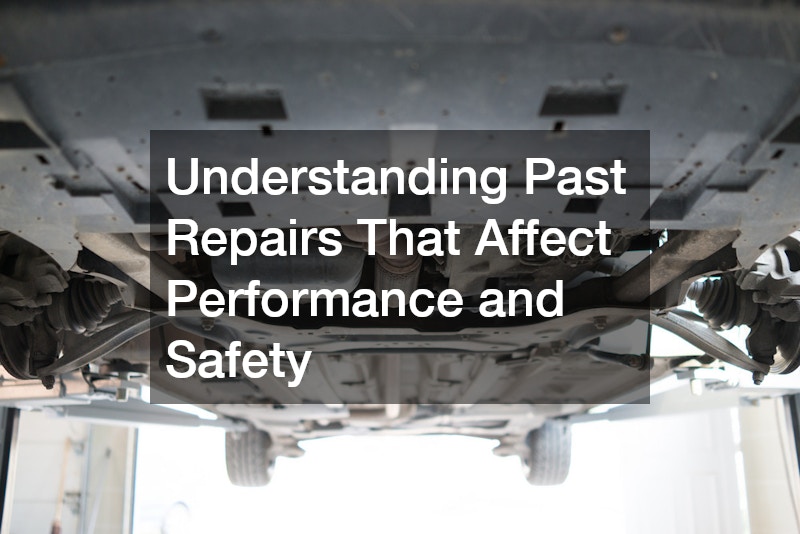In the realm of vehicle maintenance and repair, auto repair history plays a crucial role in the ongoing care and performance of a vehicle. Understanding the past repairs and modifications of a vehicle can provide invaluable insight into its current condition, potential future problems, and overall reliability. Whether it’s a matter of ensuring safety during daily commutes or optimizing performance for off-road adventures, the history of maintenance and repairs is a key piece in the puzzle. Ignoring this aspect not only jeopardizes vehicle performance but also can lead to higher repair costs and safety issues. Auto owners and repair professionals alike are now paying closer attention to comprehensive repair documentation, from basic brake repairs to major transmission repair services, with the understanding that a well-documented history can serve as a roadmap to better vehicle management. As we delve into this topic, we will explore how a detailed auto repair history can reveal everything from past mechanical issues to the impacts of usage habits, helping drivers anticipate and manage future repair needs effectively.
Understanding Past Repairs That Affect Performance and Safety

Every vehicle has a story to tell through its auto history. Past repairs give insight into the lifespan and durability of the vehicle, and in particular, transmission repair services shed light on its operational efficiency. Transmission issues are often linked with noticeable performance discrepancies like gear slipping or rough shifts, which, if not handled on time, can evolve into more severe problems.
Moreover, retaining a thorough auto repair history aids mechanics in addressing potential faults that might not be visibly evident. By reviewing past interventions, technicians can more easily diagnose recurring issues, thereby enhancing safety outcomes and minimizing additional costs. In serious cases, understanding past repair work can significantly impact the resale value and perceived reliability of the vehicle.
From minor fixes to major overhauls, each entry in the vehicle’s repair history is a step toward informed vehicle maintenance. For every vehicle owner, being aware of past repairs is not only about maintaining current functionality but ensuring peace of mind when traveling, knowing their vehicle is in safe condition. Therefore, maintaining updated and accurate repair documentation is paramount to both performance optimization and safety assurance.
The Role of Detailed Records in Diagnosing System Failures
Detailed records of auto repair history play a pivotal role when issues within a system need diagnosis. Among various components, examining past hydraulic cylinder services can help gauge and troubleshoot failures in mechanical systems reliant on hydraulic operations. These records are particularly useful in identifying patterns of wear and tear or failure within complex systems, which might otherwise go unnoticed.
An extensive repair history allows mechanics to foresee potential failures before they escalate into more significant problems. It provides a window into previous diagnostics and solutions, facilitating efficient and effective maintenance. Correcting a problem is more straightforward when its history is well-documented, as seen in cases with repeatedly serviced hydraulic systems.
Regular documentation aids in building a cumulative knowledge base for the vehicle, ensuring that each new repair or service adds to the understanding of the vehicle’s conditions. This is valuable not just for mechanics, but also for the owner, enabling proactive rather than reactive maintenance strategies which improve the vehicle’s lifespan and operational viability.
Why Replacement Parts History Impacts Future Maintenance Needs
An accurate auto repair history that includes the replacement of parts is crucial to predicting and preparing for future maintenance needs. Take, for instance, the custom off-road drive shaft; replacing this part indicates either a past failure or a performance upgrade, both of which require ongoing monitoring to ensure continued effective performance. Understanding the timeline and reasoning behind past part replacements aids in crafting a tailored maintenance plan.
Furthermore, certain replacement parts may require more frequent checks or earlier replacements due to their usage intensity or the conditions they endure. Knowing which parts have been replaced, and under what circumstances they were installed, helps owners make informed decisions about future investments, ensuring the vehicle operates optimally without unexpected breakdowns.
This understanding also assists mechanics in aligning scheduled maintenance with the vehicle’s specific needs. As parts and systems within vehicles are interdependent, a well-documented history avoids overlapping repairs, thereby reducing costs and improving repair accuracy. Moreover, it assists in preemptively handling parts before they reach their inevitable service exit, thus ensuring vehicle reliability.
What You Can Learn About a Vehicle’s Driving and Usage Habits

A comprehensive auto repair history often paints an informative picture of a vehicle’s driving and usage habits. For example, frequent glass replacement service might indicate common exposure to off-road conditions or areas with high rates of flying debris. Such history informs owners and mechanics about the driving conditions the vehicle frequently endures.
Moreover, understanding these habits helps in adjusting maintenance schedules to fit the vehicle’s unique operating environment. If a vehicle often requires replacement parts known for wear due to harsh driving conditions, preventive measures can be enhanced. This knowledge is invaluable to avoiding component failures and sudden breakdowns, thereby polishing the vehicle’s performance.
Driving habits can also affect fuel efficiency, wear patterns on brakes, and overall engine health. By monitoring auto history and recognizing recurrent service patterns, both owners and technicians can make educated adjustments to upkeep, always staying a step ahead of potential issues. This proactive approach reduces the cost and improves the longevity of the vehicle.
Knowing the Impact of Wear and Tear on Critical Components
With usage comes the natural degradation of vehicle components, which is an essential aspect of any thorough auto repair history. The wear and tear on critical components, such as fuel tanks, can contribute significantly to long-term maintenance strategies. Fuel tanks, subject to corrosion and leakage over time, necessitate regular inspection, bolstered by detailed historical repair records.
Regular documentation and monitoring of wear-prone components allow for better anticipation of service needs, minimizing unexpected vehicle downtime. Unresolved issues can lead to environmental concerns, such as fuel leaks, alongside safety risks that may endanger the driver and passengers. Thus, maintaining records of fuel tank servicing helps guide proper maintenance.
Understanding the historical context of component wear informs proactive resolution strategies, ensuring that critical systems remain reliable throughout the vehicle’s lifespan. Both owners and mechanics can utilize extensive repair documentation to mitigate potential risks associated with component failure, ultimately ensuring a safe and seamless driving experience.
How Service Gaps Could Affect Emergency Readiness and Response
Recognizing gaps within the auto repair history can significantly affect a vehicle’s emergency readiness and response capability. Missing services, be that a lack of maintenance from car alarm installers or other crucial aspects, could leave the vehicle vulnerable during critical situations. Consistent check-ups help ensure all safety mechanisms are in optimal working condition.
A historical lapse in services, such as the maintenance or installation of alarm systems, compromises the security and immediate response characteristics of the vehicle. Identifying and addressing these gaps allows owners to return their vehicles to a reliable state, especially in emergency circumstances where system failures can have dire consequences.
Comprehensive repair records empower owners to identify these service gaps proactively. Addressing these vulnerabilities before they impact driving security or emergency response ensures both the driver’s and vehicle’s safety. By filling these gaps, owners prioritize operational attributes that are otherwise overlooked, ensuring readiness in any situation.
Identifying Recurring Issues That Signal Long-Term Reliability Risks

Auto repair services heavily rely on auto repair history to identify recurring issues that might signal long-term reliability risks. Regular entries for similar problems indicate persistent underlying issues. Heavy focus on specific repairs, such as frequent brake repairs, may suggest deeper mechanical issues beyond simple wear and tear.
Alert technicians can recognize these patterns within repair histories, leading to more valuable diagnostic insights and logical problem-solving approaches. When a pattern is established, it becomes easier to trace the root cause, developing a more targeted approach to resolve the issues efficiently and decisively.
Regular assessments and history reviews are essential for preventing small issues from snowballing into greater risks. Ultimately, identifying these patterns allows for the strategic fortification of a vehicle’s reliability over its lifespan, facilitating a trustworthy driving experience capable of more demanding challenges.
How Cosmetic Changes Can Hide Underlying Mechanical Issues
Cosmetic tweaks and an auto wrapping service might enhance a vehicle’s aesthetic appeal, but sometimes they can mask mechanical deficiencies. Reviewing the auto repair history uncovers these underlying issues when appearance upgrades seek to distract attention from mechanical faults. Thus, a meticulous document review can determine if cosmetic updates correlate with unreported mechanical repairs.
This transparency ensures that informed purchasing decisions are made, avoiding unexpected mechanical failures shortly after acquisition. Vehicle owners who neglect critical maintenance in favor of superficial improvements place themselves at risk of component failures that could cost more to resolve than the upgrades themselves.
Thus, while visual enhancements can significantly boost resale value, their effectiveness is closely aligned with a clear mechanical history. Clear documentation ensures a balance between aesthetic desires and the preservation of vital operational integrity, reinforcing overall vehicle reliability and value.
In some cases, cosmetic changes may even be used to conceal signs of past damage, such as frame repairs, corrosion, or poorly aligned panels resulting from accidents or structural issues. Without reviewing the auto repair history, buyers may miss these red flags entirely. A thorough inspection combined with service records helps determine whether visual enhancements were part of routine upgrades or attempts to cover deeper problems.
Spotting Early Warning Signs Before They Become Expensive Problems
Identifying and addressing early warning signs is critical to any auto repair history. Mechanical issues such as those related to brake repairs often exhibit early detectable signs, allowing for preventative measures before they intensify. By regularly examining repair history, potential problem areas can be highlighted, reducing future repair costs significantly.
Particular emphasis should be placed on routine inspection and timely servicing, as this proactive stance catches issues before escalating into advanced, costly repairs. Addressing problems in their nascent stages through consistent monitoring keeps maintenance expenses in check and production time to a minimum.
A well-documented history informs technicians and owners about when and where to expect typical complications, allowing proactive solutions that not only save on costs but also contribute to a safer, more reliable driving experience. This ensures that the integrity of critical systems and components is preserved.
How Repair Documentation Helps When Selling or Trading In

A complete and detailed auto repair history is a powerful tool for both selling and trading in a vehicle. Tow service companies often evaluate this document to assess the condition and past reliability before agreeing on terms. Having a rich repair history builds credibility with potential buyers, as it demonstrates a commitment to regular maintenance and care.
Sellers can command higher prices with a well-maintained record, as it reassures buyers of the vehicle’s operational status and thorough upkeep. This transparency helps in expediting the selling process, leaving minimal room for negotiation, as buyers can appreciate the significant value in preventive care.
Conversely, failing to maintain meticulous history can devalue the proposition, leading buyers to hesitate, suspecting hidden flaws or disguised issues through a lack of transparency. Overall, comprehensive and clear repair documentation serves as an advantageous asset during sales negotiations.
In conclusion, an auto repair history is more than a list of past services; it is an insightful record that equips vehicle owners with vital information to ensure long-term reliability and safety. Understanding past repairs provides an edge in diagnosing current issues and preparing for future maintenance needs, significantly impacting the overall performance and longevity of the vehicle. From identifying patterns in wear and tear to addressing gaps in emergency readiness, documented repair history is instrumental in developing comprehensive maintenance plans. Beyond maintenance, repair history holds significant value during vehicle sales or trades by providing transparency and showcasing well-maintained care, helping secure better deals while also assuring potential buyers. Ultimately, every vehicle’s life story is captured in its repair history, reflecting how it has been driven, used, and maintained over time. This history empowers both owners and mechanics with the knowledge necessary to safeguard performance, safety, and value across the vehicle’s lifespan. Therefore, an auto repair history remains an indispensable resource for anyone committed to excellence in vehicle repair and maintenance management.


